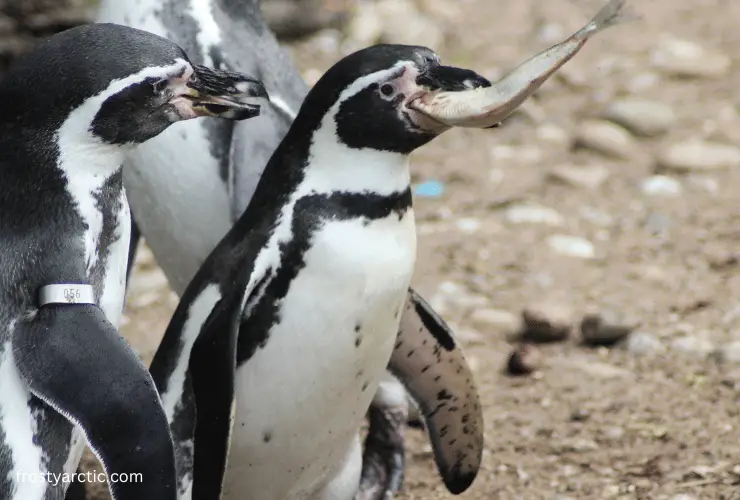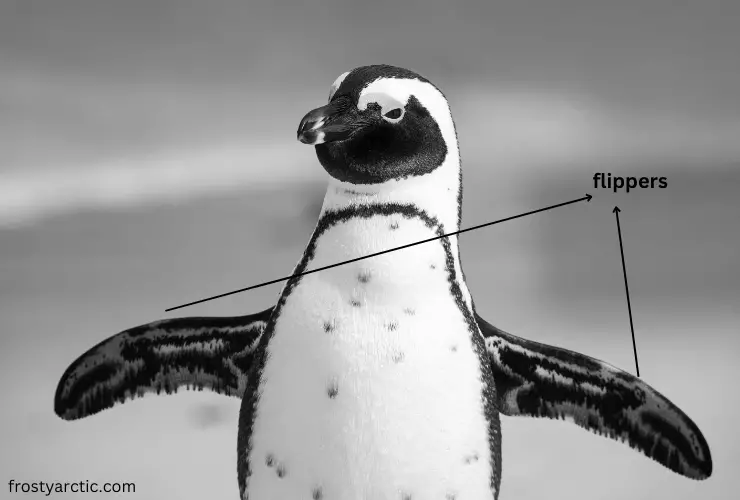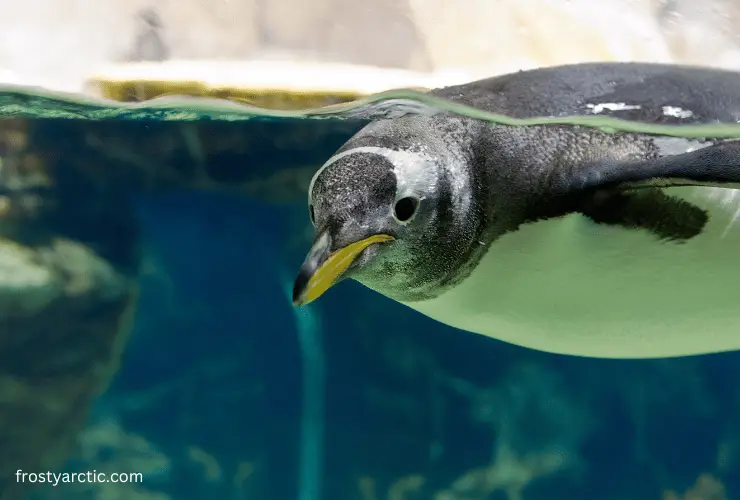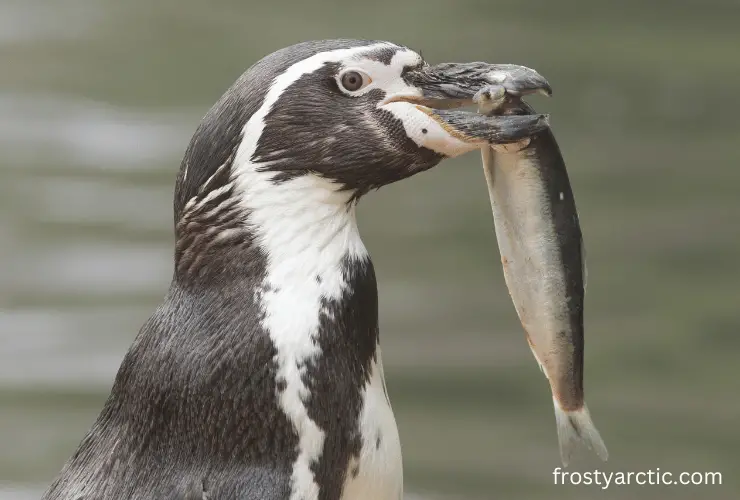Penguins mainly depend on different forms of sea life for their food intake. This commonly includes krill fishes, stone crabs, shrimps, other small fishes, and sometimes algae. Yet, on a large scale, different penguin species also have different food choices. This makes their diet diverse and helps them avoid competition for food from other sea animals.
This difference in food preference is due to their distribution in different geographical areas and availability. Another interesting fact about penguins’ diet is that they do not have developed taste buds. This means that they cannot taste their food.
If you love reading about penguins and their interesting lives, this article is for you. We will answer your queries about the diet and different eating habits of penguins, so, let’s dig further into the article.
What Do Penguins Eat for Breakfast?
Because they are carnivorous, penguins do not have a set menu for each meal of the day. Because penguins prey only during the daytime, we can say that they feed on different fishes, crustaceans, and cephalopods for breakfast. The reason for daytime prey hunting is better visibility under the sea.

List of Food Penguins Feed on for Their Breakfast
Following is a general list of foods penguins eat for breakfast.
- Fish: All species of penguins primarily feed on krill fish. Other than this, they also hunt for small fishes like silverfish, anchovies, sprat, cod, and sardines.
- Crustaceans: A diverse group of invertebrate aquatic animals from the phylum Arthropoda. Among crustaceans, penguins feed on shrimp, crabs, and small lobsters.
- Cephalopods: They are soft-bodied animals that belong to the phylum Mollusca. Among cephalopods, penguins feed on different species of cuttlefish and small squid.
What Do Penguins Eat for Lunch?
Penguins consume the same kind of food, regardless of whether it is lunch or breakfast. Although, their food intake depends on the availability of the food, the season, and the geographical area they inhabit.
Krill fish is a favorite diet of all penguins, but if there is a shortage of krill fish, they will look for other food sources. Penguins usually feed on small fish and crustaceans available under the sea.
However, they also hunt for aquatic animals that come to the surface of the ice, like crabs. Penguins can also store food. Hence, if they consume enough fish in the morning, they will store it for lunch and dinner.
What Do Penguins Eat Besides Fish?
Penguins are piscivorous, meaning that they hunt different forms of aquatic animals other than fish. Penguins compete with other animal species for food as part of a large food chain. Therefore, they have an extended and diverse diet to avoid food shortages.
3 food sources that penguins hunt for other than fish
Following is a detailed list of foods penguins hunt for other than fish:
- Cuttlefish: It is a cephalopod that is usually hunted by Magellanic penguins.
- Squids: They are soft-bodied mollusks. They are the food of African penguins and yellow-eyed penguins.
- Crustaceans: They are invertebrate animals living under the sea. Fiordland crested penguins feed on crustaceans that are available around their habitats.
Different species of penguins feed on different prey that they can find according to their habitat.
What Do Emperor Penguins Eat in Antarctica?

Emperor penguins feed on common small fish and other sea animals to fulfill their food and nutrition needs. Emperor penguins can change their diet according to the availability of their prey and season.
- Food In Winter: During winter, the diet of Emperor penguins mainly comprises krill, fish and silverfish. Krill is a lobster-like aquatic animal that becomes abundantly available during the winter.
- Food In Summer: In summer, Emperor penguins rely mostly on squids, cod, and sometimes algae. These small sea animals provide the penguins with high-fat content that gives them more energy.
What Do Penguins Eat in The Tundra/Arctic?
Emperor and Adelie penguins are the only two penguin species that are native to tundra biomes in the southern hemisphere of the world. They feed extensively on krill fish, squids, crabs, crustaceans, cuttlefish, and other small fish.
The food availability for the penguins of tundra biomes is largely affected by two factors:
- One is intra-species competition for food and
- The other is commercial fishing.
Krill fish and other fish are also the food sources for other animal species that inhabit tundra. Therefore, penguins constantly rival these species to get their food.
Commercial fishing around the habitats of penguins is decreasing their food availability. This food scarcity is leading their species toward the threat of extinction.
What Do Penguins Eat in the Wild?
Penguins are piscivorous creatures that only depend on the meat of sea animals. Penguins in the wild only inhabit areas closer to clear water resources. These penguins hunt for little shrimp, squid, lobster, shrimp-like fish, and krill.
90% of the diet of these penguins depends on different small fishes. Some large species of penguins also prey on octopuses and jellyfish. These penguins’ food consumption affects the food chains and biodiversity around them.
How Do Penguins Catch the Prey?
Penguins are skilled hunters, capable of catching their meals in many ingenious ways. Let’s explore their hunting strategies and physical adaptations that make it all possible.
Unique Physical Adaptations
Penguins are a marvel of evolution. Over millions of years, these birds have evolved to possess some truly unique physical attributes that equip them to be effective hunters.
Incredible Vision
These birds have incredible underwater vision. In fact, their eyes are better suited to seeing underwater than in the air. According to an article published in the journal Vision, their corneas have a high refractive index, which helps them see underwater clearly and spot their prey.
Streamlined Body
Another crucial adaptation is their body shape. Penguins have streamlined, torpedo-like bodies that are perfect for swift underwater movement. This shape minimizes drag, enabling them to reach great speeds. Some species, like the Gentoo penguin, can swim up to 22 mph (35 kph).
Powerful Flippers

Also, penguins have powerful flippers, which function like wings underwater. These flippers provide the propulsion required to chase and catch speedy prey.
Hunting Strategies
When it comes to their hunting strategy, penguins are no less impressive. They use their superb swimming skills and agility to their advantage.
Porpoising Behavior
Many penguin species, such as the Emperor and Adelie penguins, use a technique known as ‘porpoising.’ The penguin leaps out of the water and, takes a quick breath, then dives back in. It helps them keep moving fast in the water while still being able to breathe. This way, they can travel far and wide in the ocean to find food, as indicated by the Journal of Experimental Biology.
Deep Dives

Once they spot their prey, penguins can dive deep and chase it. Some species are capable of reaching incredible depths. The Emperor Penguin, for example, can dive up to 535 meters below the surface and stay submerged for up to 20 minutes.
This impressive diving ability gives penguins access to a wide variety of prey species. They use their beak to catch the prey and swallow it whole since they lack teeth.
Social Hunting
In addition, penguins are also social hunters. They often hunt in groups, which can help them surround and capture schools of fish more effectively. According to a study published in PLOS ONE, this cooperative hunting strategy may increase their overall hunting success.
How Much Food Does a Penguin Need Daily?
Like all animals, penguins need to eat a certain amount of food daily to stay healthy and strong. But not all penguins eat the same amount. The amount of food a penguin eats depends on its age, species, size, and reproductive status. However, researchers have worked out a rough idea of how much different penguins usually eat daily.
Emperor penguins

Emperor penguins, the largest penguin species, naturally require the most sustenance. According to the WWF-UK, a fully grown Emperor penguin can consume around 2-3 kg of food daily. That is equivalent to about 4 to 6% of their body weight.
Adelie penguins
Adelie penguins are much smaller than Emperor penguins. Despite this, these penguins consume around 1.5 kg of food daily, as stated by Physiological Zoology.
Little (or Fairy) Penguins
Little Penguins, also known as Fairy Penguins, are the smallest penguin species. As you might expect, their smaller size means they require less food than their larger counterparts.
As per the insights of Phillip Island Nature Parks, Little Penguins consume about 25% of their body weight in food every day. Given their average weight of about 1 kg, that means they consume around 0.25 kilograms of food daily.
King Penguins
King Penguins are similar in stature to Emperor penguins but are slightly smaller. They have a daily food requirement that aligns more closely with their size.
A study published in Ecology found that a King Penguin can eat up to 2 kg of food daily during the summer months.
Note: Just as we sometimes eat more or less depending on the day, penguins too, sometimes eat different amounts of food daily. The amount they eat can change with the seasons, the penguin’s reproductive status, and food availability.
For instance, during the breeding season, penguins may need more food to have the energy necessary for mating, incubating eggs, and feeding chicks.
Why Do Penguins Eat Fish and Krill?
Penguins feed on different fish and krill to fulfill their bodily requirements for proteins, fats, and vitamins. These small fish provide immediate energy and nutrients because they get digested in no time.
Penguins are warm-blooded animals. Thus, the heat generated from the metabolism of this food allows penguins to maintain their body temperature.
Penguins also store food in the pouch of their stomachs to feed their babies. Once the food is partially digested, they bring it back into their mouths to feed their little ones. This food storage ability also allows penguins to store food when there is a food shortage.
FAQs
Do penguins eat fish whole?
Yes, penguins swallow fish whole because they do not have teeth in their oral cavity. Their tongue has small structures that help them swallow.
What do penguins drink?
Penguins drink salty water from the oceans or water melted from sea ice to fulfill their water requirement.
Do penguins eat plants?
Penguins are carnivorous birds. They only feed on the meat of sea animals and do not eat plants.
Do penguins eat octopus?
Yes, some large penguins prey on small octopuses for their nutritional requirements.
Do penguins eat jellyfish?
Yes, emperor penguins eat jellyfish when they go on food hunts deep in the oceans.
Conclusion
Penguins are an adorable and interesting species. They are flightless carnivorous birds that feed on krill, crustaceans, and cephalopods.
Different species of penguins also feed on other types of fish that are available around their breeding grounds. The feeding habits of Antarctic penguins also play a huge role in the food chains of tundra biomes.
Unfortunately, penguins are being pushed to the verge of extinction due to unhealthy human practices. The population of different penguin species is decreasing day by day. Increasing global warming and climate crises are also causing food shortages for the penguins. Therefore, we should cut short such practices that threaten their existence.



5 thoughts on “What Do Penguins Eat? [Complete Food List]”